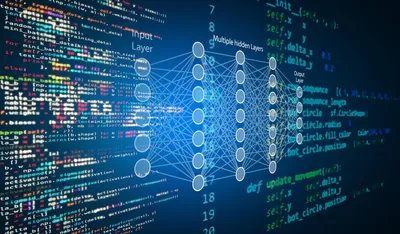As deep learning technology advances, it continues to open new doors, providing innovative solutions across various sectors. This exploration delves deeper into the practical implementations, emerging trends, and futuristic visions of deep learning, highlighting its transformative potential.
Practical Implementations
- Healthcare Revolution:
- Radiology and Imaging: Deep learning models analyze medical images such as X-rays, MRIs, and CT scans to detect anomalies, diagnose diseases, and assist radiologists. These models improve diagnostic accuracy and speed, leading to better patient outcomes.
- Genomics and Personalized Medicine: AI-driven analysis of genetic data facilitates personalized treatment plans, identifying genetic predispositions to diseases and predicting patient responses to medications.
- Financial Services:
- Fraud Detection: Deep learning algorithms detect fraudulent activities by analyzing transaction patterns and identifying anomalies. This enhances security and reduces financial losses.
- Algorithmic Trading: AI models analyze market data, predict trends, and execute trades at optimal times, increasing the efficiency and profitability of trading operations.
- Retail and E-commerce:
- Customer Insights: Deep learning analyzes customer data to provide insights into purchasing behavior, preferences, and trends. This helps businesses tailor their marketing strategies and improve customer satisfaction.
- Inventory Management: AI predicts demand for products, optimizing inventory levels and reducing overstock or stockouts, leading to more efficient supply chain management.
- Manufacturing and Industry 4.0:
- Predictive Maintenance: Deep learning models analyze sensor data from machinery to predict failures and schedule maintenance proactively, reducing downtime and operational costs.
- Quality Control: AI systems inspect products in real-time during manufacturing, identifying defects and ensuring high-quality production standards.
- Transportation and Logistics:
- Autonomous Vehicles: AI powers self-driving cars, enabling them to navigate complex environments, recognize obstacles, and make real-time decisions to ensure safe and efficient transportation.
- Route Optimization: Deep learning optimizes delivery routes for logistics companies, reducing fuel consumption, travel time, and costs.
Emerging Trends
- Edge AI:
- Decentralized Processing: Edge AI brings computation closer to data sources, such as IoT devices and sensors, reducing latency and improving real-time decision-making.
- Applications: This trend is crucial for applications requiring low latency, such as autonomous vehicles, smart cities, and industrial automation.
- Explainable AI (XAI):
- Transparency and Trust: As AI systems become more complex, understanding their decision-making processes becomes crucial. XAI provides explanations for AI decisions, fostering trust and accountability.
- Regulatory Compliance: XAI helps organizations meet regulatory requirements by ensuring that AI systems are transparent and interpretable.
- AI-Driven Creativity:
- Generative Adversarial Networks (GANs): GANs generate realistic images, music, and text, pushing the boundaries of creative expression. These models enable new forms of art, design, and content creation.
- Collaborative Creativity: AI tools assist artists, musicians, and writers in their creative processes, enhancing human creativity and productivity.
- AI for Social Good:
- Disaster Response: AI models analyze data from natural disasters to provide early warnings, assess damage, and coordinate relief efforts, improving disaster response and recovery.
- Environmental Monitoring: AI monitors environmental changes, tracks wildlife populations, and predicts climate patterns, contributing to conservation and sustainability efforts.
Futuristic Visions
- AI in Education:
- Adaptive Learning: AI-powered educational platforms adapt to individual learning styles and paces, providing personalized educational experiences and improving learning outcomes.
- Virtual Tutors: AI-driven virtual tutors provide real-time assistance and feedback to students, enhancing the learning experience and accessibility.
- Smart Homes and IoT:
- Home Automation: AI integrates with IoT devices to create smart homes that automatically adjust lighting, temperature, and security settings based on user preferences and behaviors.
- Health Monitoring: Smart home systems monitor residents’ health, providing alerts for potential health issues and assisting with elderly care.
- AI in the Arts:
- Interactive Experiences: AI creates immersive and interactive artistic experiences, blending virtual reality, augmented reality, and AI to engage audiences in novel ways.
- Digital Curators: AI curates personalized art collections and recommendations, enhancing the accessibility and appreciation of art.
- Human-Machine Symbiosis:
- Enhanced Interfaces: Brain-computer interfaces (BCIs) enable direct communication between humans and machines, enhancing accessibility for individuals with disabilities and augmenting human capabilities.
- Collaborative Robots: AI-powered robots work alongside humans in various settings, from manufacturing to healthcare, enhancing productivity and safety.
- Quantum Computing and AI:
- Quantum Machine Learning (QML): Quantum computing promises to revolutionize AI by solving complex problems faster than classical computers. QML explores new algorithms and applications, pushing the frontiers of AI.
- Hybrid Systems: Integrating quantum and classical computing creates powerful hybrid systems capable of tackling previously unsolvable problems.
Ethical Considerations
- Bias and Fairness:
- Algorithmic Bias: Ensuring that AI models are free from biases related to race, gender, and other factors is critical for fair and equitable outcomes. Continuous efforts in data curation, algorithm design, and evaluation are necessary.
- Inclusive AI: Developing AI systems that consider diverse perspectives and needs helps ensure that AI benefits all segments of society.
- Privacy and Security:
- Data Protection: Implementing robust data protection measures ensures that sensitive information is secure and used ethically.
- Cybersecurity: AI enhances cybersecurity by detecting and responding to threats in real-time, protecting critical infrastructure and personal data.
- Societal Impact:
- Job Displacement: Addressing the impact of AI on the workforce involves proactive measures such as reskilling and upskilling programs to prepare individuals for new roles in an AI-driven economy.
- Economic Inclusion: Ensuring that the economic benefits of AI are distributed equitably helps prevent societal disparities and promotes inclusive growth.
- Ethical AI Development:
- Responsible Innovation: Developing AI with ethical considerations in mind ensures that technology serves the greater good and aligns with human values.
- Global Cooperation: International collaboration on AI ethics and governance fosters a unified approach to managing AI’s impact on society.
Conclusion
Deep learning continues to be a transformative force, driving innovation across multiple sectors and addressing some of the world’s most pressing challenges. From healthcare and finance to education and the arts, the practical implementations of deep learning are reshaping our daily lives. Emerging trends such as edge AI, explainable AI, and AI-driven creativity highlight the dynamic nature of this field.
Futuristic visions of AI-integrated education, smart homes, and quantum computing paint an exciting picture of what lies ahead. However, as we harness the power of deep learning, it is crucial to address ethical considerations, ensuring that AI is developed and deployed responsibly.
The journey of deep learning is one of continuous exploration and discovery. By leveraging its potential while adhering to ethical principles, we can create a smarter, more inclusive, and sustainable world where AI enhances human capabilities and fosters a better future for all. The possibilities are endless, and the impact of deep learning is bound to shape our lives in profound ways for generations to come.



